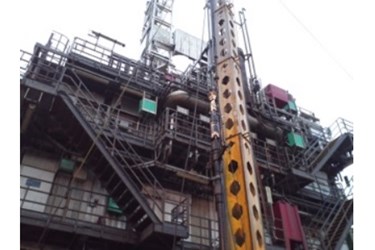Ziebel Makes History With New Composite Fiber Optic Z-Line

New System Completes First Commercial Well Intervention, Delivers Unmatched Well Diagnostics
Ziebel AS, a Stavanger-based provider of specialist well intervention services for the oil and gas industry, announced that for the first time in oil and gas history, the Z-Line, a gravity-deployed slim carbon composite cable, was used to acquire meaningful Distributed Temperature and Distributed Acoustic fiber optic data during a commercial well intervention.
The Z-Line made its inaugural run for a major operator offshore Norway. The system accessed a platform well to a depth of 9,684 ft with standard wireline-type gravity deployment and dry sealing pressure control equipment (no grease injection). All mechanical requirements of the line functioned successfully, and high quality Distributed Fiber Optic (DFO) data was acquired for the operator.
Successful performance marks commercial availability of Z-Line
“We are very pleased with the Z-Line’s successful performance during its first commercial well intervention,” said Stig Hognestad, Chief Executive Officer for Ziebel. “It marks the culmination of a thorough process of development and rigorous testing by the Ziebel team. The real significance for us – aand the industry – is that it proves that the system functions as intended in an actual live pressured well environment. With the success of this launch, the service is now available to all operators,” he added.
Z-Line builds upon the proven Z-System carbon composite technology, which delivers critical decision-making well information to oil companies. The key difference between the two is that the Z-Line does so from a smaller wireline footprint, and, being gravity deployed, with a typically shorter intervention time per well.
The Z-Line is a 3/16” (4.8mm) diameter carbon composite line with embedded optical fibers at its core. This enables Distributed Temperature Sensing (DTS) and Distributed Acoustic Sensing (DAS) to be performed along the full length of the line. In addition, Ziebel’s optical point pressure and temperature sensors are contained within the Bottom Hole Assembly (BHA), along with a connection to enable standard memory logging tools to be run below the BHA. The rig-up and footprint are similar to that of a standard wireline cased-hole setup, although the distributed measurement acquisition method does differ in that it is carried out with the line parked stationary in the well.
The carbon composite material enables the line to have an extremely high strength-to-weight ratio, with a breaking strength (6,600lbs/3,000kg) well in excess of what can be achieved with a similar diameter of steel wire or braided line. The smooth outer finish makes for effective sealing, and the low friction coefficient to steel plus the relative stiffness of the line gives it increased ability to reach into deviated wells. In addition, the low friction reduces the abrasion and tubing wear associated with standard wireline or slickline runs.
Z-Line applications
Applications that can be addressed with the service include:
- Well Integrity, producers: annular leak detection source and fluid migration behind casing detection.
- Well Integrity, injectors: verify that no unwanted injection occurs into the overburden. Decide, with confidence, whether remedial work is required or to resume injection.
- P&A: provide information to help optimize the number of plugs and to decide where they should be set, to determine where to safely cut casing strings, and to verify wellbore integrity.
- Production optimization: determine gas lift settings required for a stable flow regime and the optimal gas injection volume/production ratio. Verify that GLVs operate in the right sequence and that dummy valves are not leaking. An optimized gas lift system can increase production by up to 15% and save gas injection costs.
About Distributed Fiber Optics
DFO sensing makes it possible to continuously monitor the entire wellbore over extended periods of time. Unlike classical logging tools that can survey only a few inches of the well at a time, DFO provides a complete wellbore profile that is captured several times per second. As a result, dynamic events moving along the wellbore can be tracked, which provides a better insight into the wellbore dynamics and added confidence to well integrity decisions. For example, a gas leak migrating upwards can be followed and its speed measured, and intermittent events that would otherwise escape detection by traditional point measurement logging tools can be observed and diagnosed.
About Ziebel
Founded in Stavanger, Norway in 2006, Ziebel provides specialist well intervention services to the global oil and gas industry. Ziebel is dedicated to enhancing production effectively and economically through its pioneering well intervention technologies, including the newZ-Line and the Z-System. This proprietary fiber optic composite rod technology makes it possible to access and visualize the entire well bore in real-time. The Z-System has been used to successfully carry out more than 80 well intervention runs in the North Sea, Middle East and the US. Ziebel supports its customers from its headquarters in Stavanger, and bases in Houston, Texas and Aberdeen, Scotland.
Source: Ziebel
